What does child trafficking mean
Child trafficking is defined as the 'recruitment, transportation, transfer, harbouring, or receipt’ of a child under 18 years of age for the purpose of exploitation. The definition recognises that a child cannot consent to his or her own exploitation, regardless of whether he or she seemingly agrees to any element or genuinely understands the situation.
The Modern Slavery Act 2015 states, ‘A person commits an offence if the person arranges or facilitates the travel of another person (“V”) with a view to V being exploited’.
A child has been trafficked if he or she has been moved within a country, town or city, or across borders, whether by force or not, with the purpose of exploiting the child. This includes sexual exploitation, forced labour such as domestic servitude and forced criminality.
Any form of trafficking children is abuse. Children are coerced, deceived or forced into the control of others who seek to profit from their exploitation and suffering.
What the law says about it
In 2000, trafficking became enshrined in international law for the first time through the Palermo Protocol to Prevent, Suppress and Punish Trafficking in Persons, especially Women and Children, supplementing the United Nations Convention Against Transnational Organised Crime (2000).
There is a wide range of UK legislation and guidance relevant to trafficked and exploited children, including (but not exclusively):
- Children Act 1989, Sections 47, 67 (Private Fostering) and Children Act 2004
- Sexual Offences Act 2003 covers trafficking into, out of, or within the UK for any form of sexual offence. It also introduced new offences of abuse of children through prostitution and pornography
- The Asylum and Immigration (Treatment of Claimants) Act 2004 includes the offence of 'trafficking for exploitation' which covers trafficking for forced labour and the removal of organs
- The UK Action Plan on Tackling Human Trafficking (2007)
- Section 71 of the Coroners and Justice Act 2009 created the offences of holding another person in slavery or servitude or requiring them to perform forced or compulsory labour without the need to prove trafficking
- Human trafficking: the government's strategy (2011) sets out the UK government's plans to tackle human trafficking (adults and children) and strengthen support for victims
Trafficking and the National Referral Mechanism
Identification of trafficked children and young people may be difficult as they will be unlikely to know that they have been trafficked and what that means.
Children are trafficked for:
- sexual exploitation
- benefit fraud
- forced marriage
- domestic slavery like cleaning, cooking and childcare
- forced labour in factories or agriculture
- committing crimes, like begging, theft, working on cannabis farms or moving drugs
Children can be trafficked into the UK from other countries or be trafficked within the UK. A child may only travel from one street to the next and could still be trafficked. If a child is involved in county lines as part of criminal or sexual exploitation, then they have been trafficked.
Under Section 52 of the Modern Slavery Act, first responders have a duty to notify the National Referral Mechanism if they think a child may have been trafficked. You do not need to be certain that someone is a victim.
NRMs are completed by first responders; this includes any local authority worker, the police and certain charities; see this NRM guidance for a list of first responders.
What practitioners should do
All practitioners should make themselves aware of the indicators of child trafficking. Any practitioner who believes that a child or young person is being trafficked or is at risk of this should contact the Duty and Advice Team.
Practitioners should also be aware that children who are at risk of serious harm through trafficking, modern slavery and exploitation are often ‘hidden’ and may also be missing from education or care or home.
Key contacts and more information
Duty and Advice Team tel: 0113 376 0336 (out of hours tel: 0113 535 0600).
The National Crime Agency website Human Trafficking includes information about the Human Trafficking Centre.
The NSPCC website includes information about child trafficking.
Leeds Social Work Procedures has a chapter on Unaccompanied Migrant Children and Child Victims of Trafficking and Modern Slavery.
West Yorkshire Consortium online Safeguarding Procedures - Children from Abroad, including Victims of Modern Slavery, Trafficking and Exploitation.
Any form of trafficking children is abuse. Children are coerced, deceived or forced into the control of others who seek to profit from their exploitation and suffering.
Printable version
